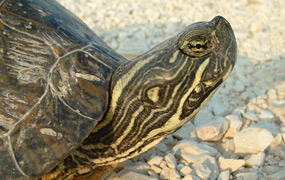 |
 | |
  | |
|
|
|
|
Amistad National Recreation Area
Reptiles
|
|
|
|
|
|
 |
 |
| NPS Photo | |
 |
Unlike many birds and insects, which appear in the park only seasonally or cyclically, reptiles can be seen at Amistad National Recreation Area nearly year round. Of the four main orders of reptiles, three can be found in the park.
Thirty-seven individual species of reptile have been sighted and verified within the boundaries of Amistad NRA; 18 more species are known to live in the area but sightings within the park have not been confirmed. Three reptiles currently found within park boundaries, the Texas indigo snake, the Trans-Pecos black-headed snake and the Texas horned lizard, are listed on the state protected or threatened species list.
Though reptiles may have descended from amphibians some 315 million years ago, modern reptiles and amphibians differ in several crucial anatomical and behavioral ways. Most importantly, reptiles are far less dependant on water for survival. While the thin, moist skin of amphibians dehydrates easily, a reptiles scaly skin helps it to retain moisture longer allowing it more freedom of range. The hard, protective cover on reptile eggs means that they do not need to reproduce in water as amphibians do. Also, reptile young generally resemble their parents while the offspring of amphibians more closely resemble fish.
Because reptiles are ectotherms (cold-blooded) they are unable to generate enough body heat to maintain a constant, internal temperature. In order to regulate their body temperature they must gather heat from the environment to stay warm and seek out shady places to cool down. This the main reason why you will see turtles and lizards “basking” on rocks in the sun. It is also the reason why many snakes can be found under rocks or low vegetation during the day.
Of the 37 reptile species known to be living in Amistad National Recreation Area, 12 are species of snake, 13 are lizard species and three are species of turtle. Though snakes have something of a bad reputation, they will generally only bite in self-defense. Take care when walking through densely vegetated areas or over loose rock and always wear protective footwear.
Remember, all reptiles are protected against harassment, killing or collecting within park boundaries. Visitors are not permitted to handle or disturb reptiles in any way.
|
|  |  |

|
 |
|
|
|
|
|
 |
|
Did You Know?
Monarch butterflies migrate through Amistad National Recreation Area in the fall, often roosting in trees by the thousands.
more...
|
|
|
|
Last Updated: February 27, 2007 at 17:22 EST |






